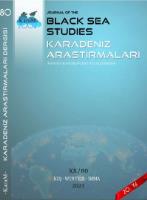OSMANLI DÖNEMİ ÖRSELLİ (ÖDEMİŞ / GÖLCÜK YAYLASI) MEZAR TAŞLARI
OTTOMAN PERIOD ÖRSELLI (ÖDEMİŞ / GÖLCÜK PLATEAU) TOMBSTONES
Author(s): Eylem Güzel, Necla Arslan Sevin, Kadir PurdeSubject(s): Archaeology, Cultural history, Customs / Folklore, The Ottoman Empire
Published by: Karadeniz Araştırmaları Merkezi
Keywords: Ödemiş; Gölcük Plateau; Ottoman Period; Gravestones; Ornamentation;
Summary/Abstract: Turks have a rich tradition of tombs and graveyards. This tradition has been preserved throughout history and has produced competent examples during the Ottoman Empire. Unfortunately, these artefacts, essential representatives of our identity, are being destroyed due to environmental conditions and the human element. The study and subsequent protection of the tombs and graveyards are crucial for our cultural heritage. In our study, we identified 34 graves belonging to the Ottoman Period in Örselli Cemetery (Gölcük/Ödemiş/İzmir). Of these graves, 15 were analysed in form, technique, and ornamentation. The graves with capitals and ornamented tombstone inscriptions were included in this analysis. According to the studies conducted within the scope of the survey on the Aydınoğulları and Ottoman Periods in the Bozdağ Plateaus with the permission of the Ministry of Culture and Tourism, the graves are generally without cists and are marked with stones and soil. The earliest of the stones with a date is H. 1172/M. 1758-59, and the latest is H. 1331/M. 1912-13. There are seven male graves and eight female graves. Generally, the tombstones of men and women have the same typology, but the headdresses and ornaments on the head tombstone inscriptions differentiate them. The male headdresses, such as turbans and fezes, are seen in these sections, and the decorations on the female gravestones point to the late Ottoman period.
Journal: Karadeniz Araştırmaları
- Issue Year: 2023
- Issue No: 80
- Page Range: 1044-1078
- Page Count: 35
- Language: Turkish

